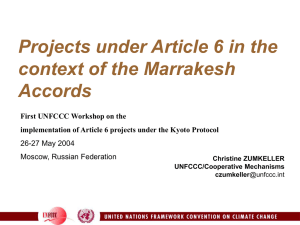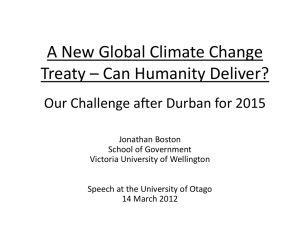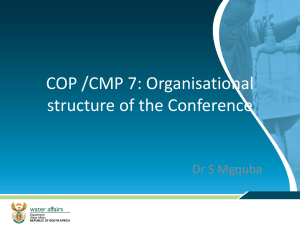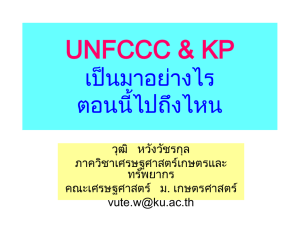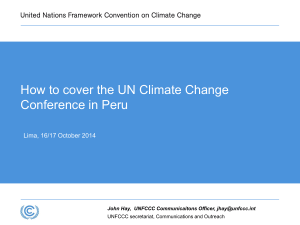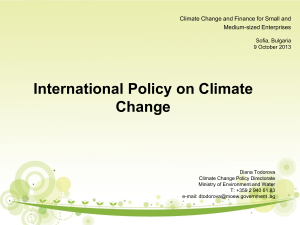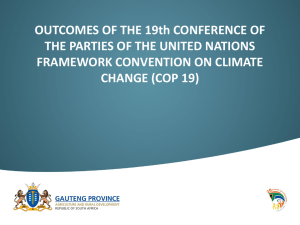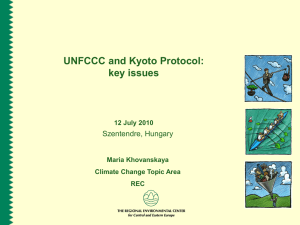International treaties, negotiations and Bangladesh position
advertisement
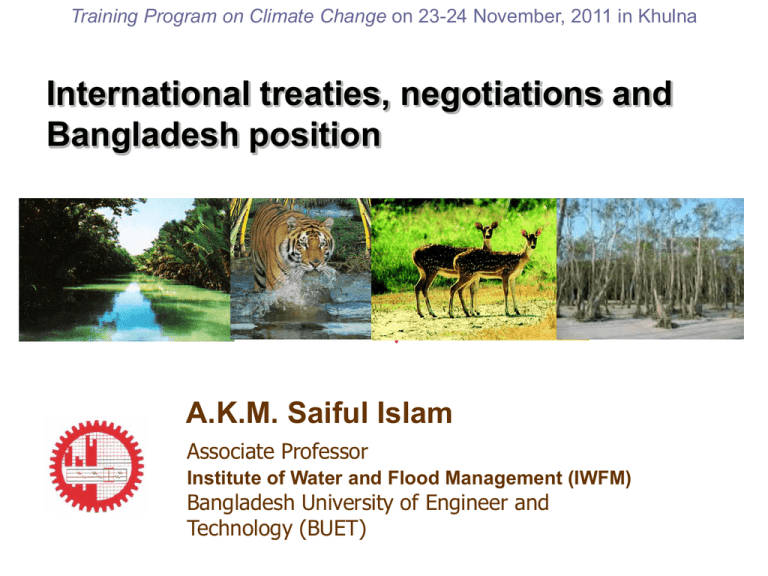
Training Program on Climate Change on 23-24 November, 2011 in Khulna International treaties, negotiations and Bangladesh position v v A.K.M. Saiful Islam Associate Professor Institute of Water and Flood Management (IWFM) Bangladesh University of Engineer and Technology (BUET) Outlines Responsibility : GHG Emission Scenarios IPCC, UNFCCC and COP Kyoto Protocol (COP1 to COP7) The Bali Action Plan (COP 13) in 2007 The Copenhagen Accord (COP15) in 2009 The Cancun Agreements (COP16) in 2010 Durban Conference (COP 17) in 2011 Bangladesh Position v Responsibility of GHG emissions v Global warming Green House gases Gas Formula Water vapor Carbon dioxide Methane Ozone H2O CO2 CH4 O3 Contributio n (%) 36 – 72 % 9 – 26 % 4–9% 3–7% Global anthropogenic greenhouse gas emissions broken down into 8 different sectors for the year 2000. CO2 from the measuring station at Mauna Loa (Hawaii) is located at a volcano at an altitude of 3400 meters. Global Emission Per capita CO2 emission Per capita emission Bangladesh 1990 – 0.1 ton 2009 – 0.36 ton v IPCC, UNFCC and COP v The Intergovernmental Panel on Climate Change (IPCC) IPCC was established in 1988 by the United Nations Environment Programme (UNEP) and the World Meteorological Organization (WMO) IPCC provides the world with a clear scientific view on the current state of knowledge in climate change and its potential environmental and socio-economic impacts. As an intergovernmental body the IPCC is open to all member countries of the United Nations and WMO. The United Nations Framework Convention on Climate Change (UNFCCC) UNFCCC has establish in 1994 to set an overall framework for global efforts to tackle the challenge posed by climate change. UNFCCC recognizes that the climate system is a shared resource whose stability can be affected by industrial and other emissions of carbon dioxide and other greenhouse gases. Currently, there are 195 Parties (194 States and 1 regional economic integration organization) to the Convention. The United Nations Framework Convention on Climate Change Governments are required to: gather and share information on greenhouse gas emissions, national policies and best practices launch national strategies for addressing greenhouse gas emissions and adapting to expected impacts, including the provision of financial and technological support to developing countries cooperate in preparing for adaptation to the impacts of climate change. COP Since the UNFCCC entered into force in 1995, the Conference of the Parties (COP) to the UNFCCC have been meeting annually to assess progress in dealing with climate change. The COP adopts decisions and resolutions, published in reports of the COP. Successive decisions taken by the COP make up a detailed set of rules for practical and effective implementation of the Convention. Chronology…(1) 1979 — The first World Climate Conference (WCC) takes place. 1988 — The Intergovernmental Panel on Climate Change is set up. 1990 — IPCC’s first assessment report released. IPCC and second World Climate Conference call for a global treaty on climate change. United Nations General Assembly negotiations on a framework convention begin. Contd..(2) 1991 — First meeting of the Intergovernmental Negotiating Committee (INC) takes place. 1992 — The INC adopts UNFCCC text. At the Earth Summit in Rio, the UNFCCC is opened for signature along with its sister Rio Conventions, UNCBD and UNCCD. 1994 — UNFCCC enters into force. An introduction to the United Nations Framework Convention on Climate Change. 1995 — The first Conference of the Parties (COP 1) takes place in Berlin. Contd..(3) 1997 — Kyoto Protocol formally adopted in December at COP3. 1996 — The UNFCCC Secretariat is set up to support action under the Convention. 2001 — Release of IPCC’s Third Assessment Report. Bonn Agreements adopted, based on the Buenos Aires Plan of Action of 1998. Marrakesh Accords adopted at COP7, detailing rules for implementation of Kyoto Protocol, setting up new funding and planning instruments for adaptation, and establishing a technology transfer framework. Contd..(4) 2005 — Entry into force of the Kyoto Protocol. The first Meeting of the Parties to the Kyoto Protocol (MOP 1) takes place in Montreal. In accordance with Kyoto Protocol requirements, Parties launched negotiations on the next phase of the KP under the Ad Hoc Working Group on Further Commitments for Annex I Parties under the Kyoto Protocol (AWG-KP). What was to become the Nairobi Work Programme on Adaptation is accepted and agreed on. Contd..(5) 2007 — IPCC’s Fourth Assessment Report released. Climate science entered into popular consciousness. At COP13, Parties agreed on the Bali Road Map, which charted the way towards a post2012 outcome in two work streams: the AWGKP, and another under the Convention, known as the Ad-Hoc Working Group on Long-Term Cooperative Action (AWG-LC) Under the Convention. Contd..(6) 2009 — Copenhagen Accord drafted at COP15 in Copenhagen. This was taken note of by the COP. Countries later submitted emissions reductions pledges or mitigation action pledges, all non-binding. 2010 — Cancun Agreements drafted and largely accepted by the COP, at COP16. 2011 — On the road to COP17 in Durban. v Kyoto Protocol v What is the Kyoto Protocol? The Kyoto Protocol is an agreement made under the United Nations Framework Convention on Climate Change (UNFCCC). The Kyoto Protocol was adopted in Kyoto, Japan, on 11 December 1997. Countries that ratify this protocol commit to reduce their emissions of carbon dioxide and five other greenhouse gases, or engage in emissions trading if they maintain or increase emissions of these gases to a 5.37% less than 1990. The Kyoto Protocol It sets binding targets. At the real heart of the Kyoto Protocol lies its set of legallybinding emissions targets for reducing greenhouse gas emissions for 37 industrialized countries and the European Union. These emissions targets amount to a total cut, among all Annex I Parties, of at least 5.37% from 1990 levels by 2008-2012. Commitments: Annex B Country EU-15 US** Canada Japan Russian Federation Norway Australia Iceland Target – 1990* -8% -7% -6% -6% 0 +1% +8% +10% *Some EITs have baseline year other than 1990. **US does not intend to ratify the Protocol. Kyoto Protocol -Country Targets Country Australia Austria Belgium Bulgaria Canada Croatia Czech Republic Denmark Estonia European Community Finland France Germany Greece Hungary Iceland % of base 108 92 92 92 94 92 92 92 92 92 92 92 92 92 94 110 Country Italy Japan Lithuania Netherlands New Zealand Norway Poland Portugal Romania Russian Federation Spain Sweden Switzerland Ukraine United Kingdom United States % of base 92 94 92 92 100 101 94 92 92 100 92 92 92 100 92 93 Implementation: Mechanisms The Kyoto Protocol defines three innovative “flexibility mechanisms” to lower the overall costs of achieving its emissions targets. The Kyoto Protocol broke new ground with its three innovative mechanisms: Joint implementation, The clean development mechanism (CDM) Emissions trading. Implementation: Mechanisms All three mechanisms operate on the basis of accounting units. Joint implementation projects result in emission reduction units (ERUs) CDM projects generate certified emission reductions (CERs) and, Under emissions trading, Annex I Parties may exchange assigned amount units (AAUs). Joint Implementation (JI) Joint implementation (JI) allows Annex I Parties to implement projects that reduce emissions, or increase removals by sinks, in the territories of other Annex I Parties. For example, replacing a coal-fired power plant with a more efficient combined heat and power plant. Currently Russia and Ukraine are slated to host the greatest number of JI projects The clean development mechanism (CDM) Provides for Annex I Parties to implement project activities that reduce emissions in non-Annex I Parties, in return for certified emission reductions (CERs). The economic basis for including developing countries in efforts to reduce emissions is that emission cuts are thought to be less expensive and weaker environmental regulations in developing countries than developed countries. In 2005 , CDM expected Emission trading Emissions trading, allows countries that have emission units to spare - emissions permitted them but not "used" - to sell this excess capacity to countries that are over their targets. Thus, a new commodity was created in the form of emission reductions or removals. Since carbon dioxide is the principal greenhouse gas, people speak simply of trading in carbon. Carbon is now tracked and traded like any other commodity. This is known as the "carbon market." Land Use, Land-Use Change and Forestry (LULUCF) The rate of build-up of CO2 in the atmosphere can be reduced by taking advantage of the fact that carbon can accumulate in vegetation and soils in terrestrial ecosystems. Any process, activity or mechanism which removes a greenhouse gas from the atmosphere is referred to as a "sink.“ A removal unit (RMU) on the basis of land use, LULUCF activities such as reforestation U.S. Response to the Kyoto Protocol The U.S. is the world’s single-largest source of CO2 emissions, accounting for 36% in 1990. As such, U.S. ratification would clearly push the Kyoto thermometer above the 55% threshold and thus, bring the Protocol into force. However, in March of 2001 President George W. Bush steadfastly rejected the Kyoto Protocol citing the “fact” that, “The Kyoto treaty would severely damage the United States’ economy…” Why Does the U.S. Hesitate? Developing Countries are not included in the agreement. Although the U.S. is currently the top emitter of carbon, China will overtake the U.S. by 2030. U.S. Senate Opposition In 2005, the U.S. Senate unanimously passed by a 95–0 vote the Byrd-Hagel Resolution (S. Res. 98) which stated the sense of the Senate was that the United States should not be a signatory to any protocol that did not include binding targets and timetables for developing as well as industrialized nations or "would result in serious harm to the economy of the United States". Cutting Green house gas emission Plan ? Situation ! Future ! v Recent COPs (from Bali to Durban) v The Bali Action Plan (5 point plan) 1. 2. 3. 4. 5. The Bali Action Plan was agreed upon at COP 13 in December, in Bali, Indonesia. It calls for the full, effective and sustained implementation of the UNFCCC through long-term cooperative action up to and beyond 2012 by addressing : A shared vision for long-term cooperative action, including a long-term global goal for emission reductions. Enhanced national/international action on mitigation of climate change. Enhanced action on adaptation. Enhanced action on technology development and transfer to support action on mitigation and adaptation. Enhanced action on the provision of financial resources and investment to support action on mitigation and adaptation and technology cooperation. The Copenhagen Accord The 15th session of the Conference of Parties (COP 15) to the UNFCCC took place in Denmark in the city of Copenhagen. COP 15 noted the Copenhagen Accord at the final plenary on 18 December 2009. Countries had to pledge their CO2 emission reductions. The Accord is not legally binding and does not commit countries to agree to a binding successor to the Kyoto Protocol. An assessment of the implementation of this Accord is to be completed by 2015. The Cancun Agreements COP 16 was held in Cancún, Mexico in 2010 Arising thereof the Cancun Agreements were adopted. The Cancun Agreements are a set of significant decisions: 1. The international community agreed to address the long-term challenge of climate change collectively and comprehensively over time and to take concrete action now to speed up the global response. 2. The agreements represent key steps forward in capturing plans to reduce greenhouse gas emissions and to help developing nations protect themselves from climate impacts and build their own sustainable futures. Towards a new agreement in 2012 Kyoto Protocol reaches its sell by date in 2012. Processes have been taking place to replace it with a new binding agreement. In 2007, The Bali Action Plan sought such an agreement. COP 15 which took place in Copenhagen called for a new deal but could only come up with the Copenhagen Accord. COP 16 which took place in Mexico in 2010 resulted in the CANCUN AGREEMENTS. It is up to South Africa to ensure that a solid agreement is to happen in 2012. COP 17 Conference of Parties (COP) refers to the States that have signed on to the United Nations Framework Convention on Climate Change (UNFCCC). The parties have been meeting annually in Conferences of the Parties (COP) to assess progress in dealing with climate change since 1995. COP 17 is therefore the 17th Conference that will take place at the end of this year (2011). The COP 17- CMP 7 will mark a critical moment in the ongoing international climate change negotiations. CMP 7 means the seventh meeting of the Parties since the Kyoto Protocol was signed. COP 17 : 2011 United Nations Climate Change Conference The 2011 United Nations Climate Change Conference will be held in Durban, South Africa, from 28 November to 9 December 2011. Officially it is referred to as the 17th session of the Conference of the Parties (COP 17) to the UNFCCC. It is also the 7th session of the Conference of the Parties serving as the meeting of the Parties (CMP 7) to the Kyoto Protocol. In addition, the two permanent subsidiary bodies of the UNFCCC – the Subsidiary Body for Scientific and Technological Advice (SBSTA) and the Subsidiary Body for Implementation (SBI) – are likely to hold their 35th sessions. v Bangladesh Position v Source: MoEF, Bangladesh Mitigation: Bangladesh Position Emphasizing a legally-binding mid term and long term emission reduction targets by Annex I Parties with 40% by 2020 and 85% by 2050 below 1990 levels. Based on IPCC AR4, global emission reduction efforts must ensure at least 25-40% below 1990 levels by 2020 for Annex I and significantly below business as usual (BAU) emissions in 2020 for the non-Annex I countries as a group. Nationally Appropriate Mitigation Action (NAMA) Registry , proposed in Bali, should be web based and supported by developed countries. Registry should not become a prior requirement or bottleneck to access funding, including from the Green Climate Fund (GCF). Source of information: Dr. Monjurul Hannan, Deputy Sec., MoEF Mitigation: Bangladesh Position cont… Loopholes in LULUCF and market-based mechanisms that degrade reduction targets need to be excluded. The global goals and limits must include emissions from international shipping and aviation A legally binding agreement that is fair, effective, comprehensive and robust ensuring global environmental integrity Durban should launch a clear roadmap with reasonable timeframe agreed by Parties towards reaching a legally binding agreement. Source of information: Dr. Monjurul Hannan, Deputy Sec., MoEF Adaptation: Bangladesh position Adaptation Committee for Macro Management Priority should be country driven GCF or other financial entities will allocate resources for project implementation Linkages with funding mechanism and technology Source of information: Dr. Monjurul Hannan, Deputy Sec., MoEF Adaptation: Bangladesh position Finalization of adaptation text in Durban and operationalization adaptation activities Member from LDCs in Adaptation Committee Adaptation Committee must be under COP, not under any other subsidiary body such as SBI Balanced allocation for Adaptation and Mitigation Urgent and immediate fund for NAPA and BCCSAP implementation Source of information: Dr. Monjurul Hannan, Deputy Sec., MoEF AWG-KP: Bangladesh position Five year 2nd commitment period of KP after 2012 Strong political decision is critical Finalization and adoption of legally binding agreement ASAP No more flexible mechanism for parties those are not in favor of KP 2nd cp Source of information: Dr. Monjurul Hannan, Deputy Sec., MoEF Technology: Bangladesh position Operationalization of Clean Technology Center (CTC) and Networks at Durban Country driven priority for technology access and transfer Technology access, transfer and capacity building must be supported Emphasis on both adaptation and mitigation technology Linkages of technology with finance Source of information: Dr. Monjurul Hannan, Deputy Sec., MoEF Finance: Bangladesh position Transparency on Fast Start Fund (proposed in Copenhegen and Cancun of US$ 30 billion for the period 2010-2012) with urgent and immediate fund release Mobilize of Green Climate Fund (GCF) in Durban [pledged 100 billion per annum] A clear work plan on pledged of Annex I from post 2012 and up to 2020 for approval by COP 17 Direct access of fund by LDCs through national funding mechanism i.e. BCCTF (trust) and BCCRF (resilience) Balanced allocation for adaptation and mitigation Urgent and immediate fund for National Adaptation Program of Action (NAPA) and Bangladesh Climate Change Strategy and Action Plan (BCCSAP) implementation Source of information: Dr. Monjurul Hannan, Deputy Sec., MoEF Thank you
